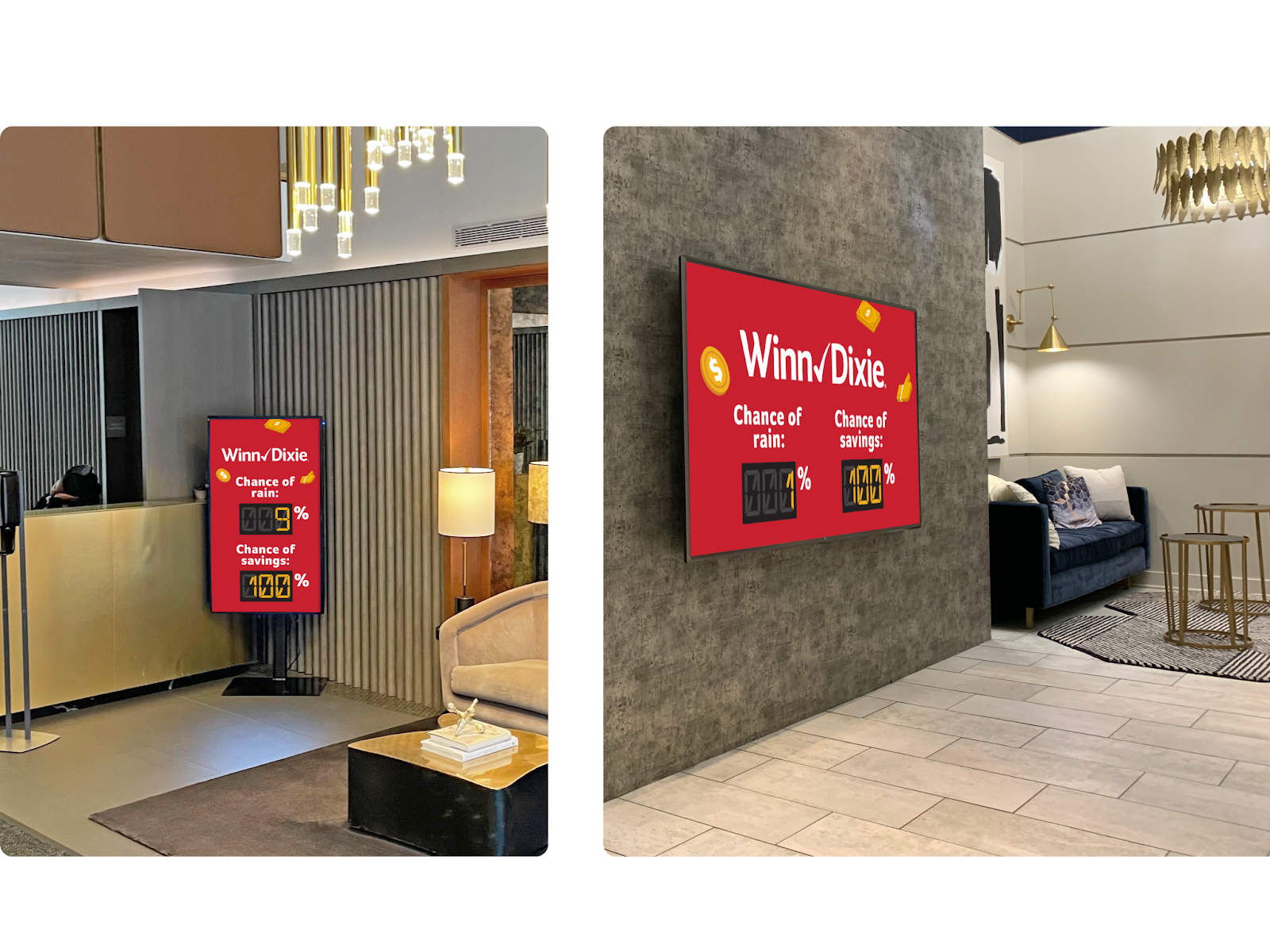Imagine this: A luxury travel company is running an ad targeting potential customers. At 2 PM, the ad displays the message, ‘Escape to paradise with exclusive tropical getaways,’ but as soon as the clock hits 5 PM and the evening rain rolls in, the message shifts seamlessly to, ‘Rainy day blues? Plan your sunny escape today.’
This is the result of Dynamic Creative Optimization (DCO) at work. DCO is a cutting-edge advertising technology that uses data to tailor ad creative in real-time to make campaigns more relevant and engaging for every consumer. By leveraging information like location, time of day, weather, browsing behavior, and more, DCO ensures that every impression delivers the most compelling message to its audience. The result? Higher engagement, better customer experiences, and improved return on investment (ROI) for advertisers.
Understanding dynamic creative optimization for DOOH
In a world accustomed to junk emails, spam phone calls, generalized commercials, and constant advertising, personalization is key. 71% of consumers prefer ads tailored to their interests and shopping habits.
Unlike traditional advertising, which serves generalized ad copy and creative to the masses, DCO crafts ads in real time. Dynamic creative optimization uses demographic, behavioral, psychographic, and additional consumer data to generate up to one thousand variations of ad creative. Combining user data and contextual information enables DCO technology to develop ads that resonate with each individual.
Multiple ad variations allow advertisers to go beyond what the typical A/B testing offers. The system can quickly generate hundreds of options and choose the most relevant advertisement to serve consumers.
Montana Accavallo, the Vice President of Client Success & Programmatic Partnerships at Screenverse, brings deep expertise in driving innovation within the digital out-of-home space. Speaking on the transformative potential of dynamic creative optimization, she shares, “For advertisers, DCO unlocks the ability to scale personalized storytelling across diverse out-of-home environments, making DOOH a powerful and strategic channel for modern marketing.”
Applying DCO to your campaign
Applying dynamic creative optimization to a programmatic digital out-of-home (prDOOH) campaign is easier than it seems. Begin by identifying the data triggers you want to use, uploading your creative assets, and defining the rules determining when each variation should be displayed. Once these settings are configured within the supply-side platform (SSP), the platform will automatically deliver the appropriate creative to the right screen, ensuring your campaign adapts seamlessly to real-time conditions.

Screenverse partners with major SSPs such as Place Exchange, Vistar Media, Hivestack, and Broadsign, which are equipped to simplify this process. While the technology is complex, thanks to our partnerships with SSPs, it’s easy to set up dynamic creative on a Screenverse network.
Why dynamic creative optimization is efficient
As technology continues to evolve, so do marketing strategies. According to Digiday’s 'The State of Dynamic Advertising’ Report, 99% of agencies said that DCO plays a significant factor in their work. Some key benefits include:
- Real-time adaptability
- Personalization at scale
- Improved relevance
- A/B testing and iteration
- Enhanced engagement
- Messaging sequencing
- Adapting to user behavior
- Localization and geotargeting
- Data-driven creativity
- Reduced ad fatigue
- Creative flexibility
- Optimized ad spend
- Enhanced performance analytics
Realistically, most advertisers care about one thing—return on investment. This makes it crucial for marketers to back their marketing strategy with insights and data. As soon as a programmatic DCO campaign goes live, it collects insights about which aspects of the creative, messaging, and targeting deliver the best results. It even allows integrating foot traffic data and setting rules into the demand-side platform (DSP) to track campaign success seamlessly. This way, if performance goals aren’t being met, the marketer will immediately know and be able to pivot and adjust the campaign.
Another strategic benefit of programmatic and DCO is the ability to run multiple campaigns simultaneously, thus gathering more valuable feedback in a shorter timeframe.
The rise of generative AI and how it’s used in DOOH
Dynamic creative optimization is not a new concept—it has been around since the mid-2010s, but has evolved in recent years thanks to generative AI. With the global AI market set to grow by 38% in 2025, all signs point to DCO advancing and becoming even more prominent in programmatic technology.
Generative AI is designed to create new content, whether it be text, images, music, or other forms of media, based on patterns it has learned from existing data. Unlike traditional AI, which is often used for tasks like classification or prediction, generative AI can produce original outputs that mimic the structure or style of the data it was trained on.
It’s especially helpful in speeding up the process of crafting ad campaigns so that brands can explore a variety of ideas, offering a more diverse set of options to test in real time. Over 80% of marketers have already incorporated AI into their marketing strategies and have seen insurmountable success.
Why 2025 is the perfect time to test DCO
As programmatic DOOH grows, dynamic creative optimization will scale along with it. Gone are the days when consumers will see a generalized ad for a brand they’ve never heard of and make a purchase. The digital landscape has revolutionized the expectations and needs of consumers; with such a fast-paced environment, tools like DCO that gather data and have the ability to shift on a whim meet these needs and are crucial to brands.
As consumer expectations continue to evolve, integrating both automation and manual control becomes essential for brands to stay competitive, and that's where DCO truly shines. For those ready to implement dynamic creative optimization in their campaigns, contact us to learn more about where to begin.

%20(10).jpg)







.png)